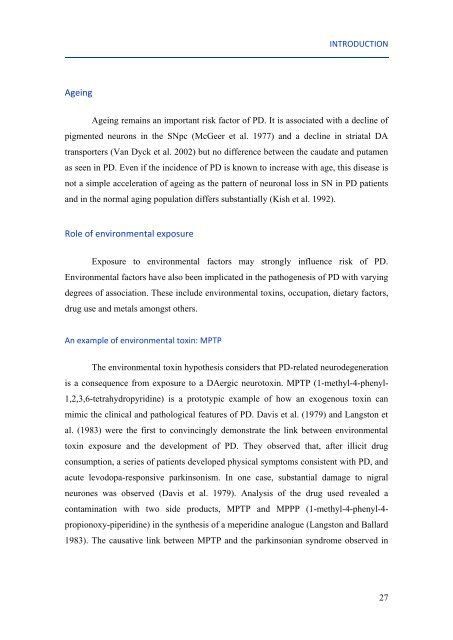Mechanisms of aluminium neurotoxicity in oxidative stress-induced ...
Mechanisms of aluminium neurotoxicity in oxidative stress-induced ...
Mechanisms of aluminium neurotoxicity in oxidative stress-induced ...
You also want an ePaper? Increase the reach of your titles
YUMPU automatically turns print PDFs into web optimized ePapers that Google loves.
Age<strong>in</strong>g<br />
INTRODUCTION<br />
Age<strong>in</strong>g rema<strong>in</strong>s an important risk factor <strong>of</strong> PD. It is associated with a decl<strong>in</strong>e <strong>of</strong><br />
pigmented neurons <strong>in</strong> the SNpc (McGeer et al. 1977) and a decl<strong>in</strong>e <strong>in</strong> striatal DA<br />
transporters (Van Dyck et al. 2002) but no difference between the caudate and putamen<br />
as seen <strong>in</strong> PD. Even if the <strong>in</strong>cidence <strong>of</strong> PD is known to <strong>in</strong>crease with age, this disease is<br />
not a simple acceleration <strong>of</strong> age<strong>in</strong>g as the pattern <strong>of</strong> neuronal loss <strong>in</strong> SN <strong>in</strong> PD patients<br />
and <strong>in</strong> the normal ag<strong>in</strong>g population differs substantially (Kish et al. 1992).<br />
Role <strong>of</strong> environmental exposure<br />
Exposure to environmental factors may strongly <strong>in</strong>fluence risk <strong>of</strong> PD.<br />
Environmental factors have also been implicated <strong>in</strong> the pathogenesis <strong>of</strong> PD with vary<strong>in</strong>g<br />
degrees <strong>of</strong> association. These <strong>in</strong>clude environmental tox<strong>in</strong>s, occupation, dietary factors,<br />
drug use and metals amongst others.<br />
An example <strong>of</strong> environmental tox<strong>in</strong>: MPTP<br />
The environmental tox<strong>in</strong> hypothesis considers that PD-related neurodegeneration<br />
is a consequence from exposure to a DAergic neurotox<strong>in</strong>. MPTP (1-methyl-4-phenyl-<br />
1,2,3,6-tetrahydropyrid<strong>in</strong>e) is a prototypic example <strong>of</strong> how an exogenous tox<strong>in</strong> can<br />
mimic the cl<strong>in</strong>ical and pathological features <strong>of</strong> PD. Davis et al. (1979) and Langston et<br />
al. (1983) were the first to conv<strong>in</strong>c<strong>in</strong>gly demonstrate the l<strong>in</strong>k between environmental<br />
tox<strong>in</strong> exposure and the development <strong>of</strong> PD. They observed that, after illicit drug<br />
consumption, a series <strong>of</strong> patients developed physical symptoms consistent with PD, and<br />
acute levodopa-responsive park<strong>in</strong>sonism. In one case, substantial damage to nigral<br />
neurones was observed (Davis et al. 1979). Analysis <strong>of</strong> the drug used revealed a<br />
contam<strong>in</strong>ation with two side products, MPTP and MPPP (1-methyl-4-phenyl-4-<br />
propionoxy-piperid<strong>in</strong>e) <strong>in</strong> the synthesis <strong>of</strong> a meperid<strong>in</strong>e analogue (Langston and Ballard<br />
1983). The causative l<strong>in</strong>k between MPTP and the park<strong>in</strong>sonian syndrome observed <strong>in</strong><br />
27

















